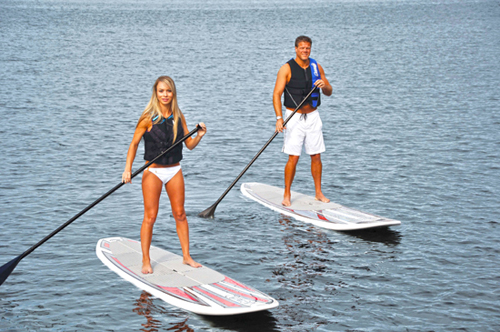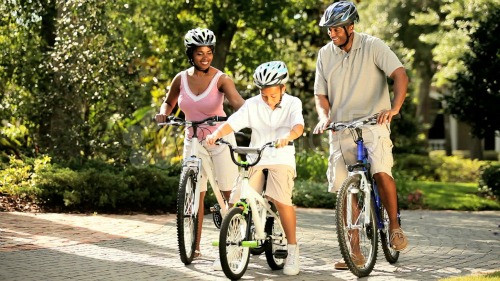Proper Ergonomics of Summer Activities
June 1st, 2015
Golfing…
As warmer weather approaches, golfers
are anxious to get to the first tee. But twisted postures, the torque of the swing and forgetting to warm up can cause unnecessary injury. On the surface, the physical demands of golf appear minimal; however, probing deeper reveals that the golf swing actually produces forces of up to 8 times an individual’s body weight. Combining these forces with the repetitive nature of the sport, it is not surprising that low back pain constitutes 26-52% of all golf-related injuries. In addition, trunk muscle imbalances, poor biomechanics, and a lack of flexibility specifically in the leading hip have been cited as possible causes for golf-related low back pain. (Gluck, 2008)
Tips for Safer Golfing:
Get the Right Fit: Playing with clubs that don’t fit can hinder your game and cause you pain. Consult a pro to ensure that your clubs are the right height, are made of a material appropriate to your arm strength, and have the right grip for you.
Take Lessons: The right swing technique can do more than just improve your golfing, it can also spare you plenty of unnecessary pain.
Warm Up and Warm Down: Take a few minutes to stretch before and after your game.
Push, Don’t Carry Your Golf Bag: Pushing or pulling your bag and taking a golf cart can help you prevent a back injury.
Choose the Right Shoes: Wearing a golf shoe with good support and the proper fit can prevent some knee, hip and lower back pain.
Hydrate: Dehydration can cause fatigue and increase your risk of injury.
Video tape your summer activity and email it to Dr. Barbara Rodwin to review your ergonomics!
Dr.Rodwin@back2health4you.com
Stand Up Paddle Boarding (SUP)
Just think: the water beneath you, the sky all around, your paddle in your hand and each efficient stroke propelling you forward: it sounds perfect, doesn’t it? It’s important to have a stand up paddle that’s going to give you the result you want and make your experience enjoyable. Paddles come in different shapes and sizes and are made of various materials. Choosing the right paddle—considering ergonomics, shape and size of handle, shaft and blade—maximizes your enjoyment on the water. Experts say that the paddles are even more important than the SUP, since this is what is propelling the board. If you plan to travel distance or spend a significant amount of time on a paddle board, you might consider a lightweight paddle to avoid muscle strain. Blades that are larger pull more water, but require more effort; narrower blades allow for quicker strokes for racing speed. How that handle, handles depends on ergonomics. The overall length of the paddle is very important: how long the paddle is relative to your height has a direct effect on your technique and paddling efficiency.
For other types of paddling, please ask one of our health care providers for tips on proper ergonomics!
Bicycling…
Bicycling is another very popular summer activity. Bicycles are made for different types of activities and are available in a range of shapes and sizes. Proper selection, fit and adjustment of the bicycle can prevent injuries and provide long term health benefits. The nature of bicycling can put riders at risk of repetitive strain injuries. Almost one out of every two cyclists experience discomfort or injuries when riding. The neck and shoulders, back, hips, buttocks and groin area, as well as the arms, hands, legs and feet are at risk due to repetitive motion, muscle exertion, and soft tissue compression.
Tips for Safer Cycling:
Handlebar Position: The distance and height of the handlebar are important to ensure that excessive pressure in not placed on elbows, wrists and palms. Pressure points can result in joint pain or hand and finger numbness. Handlebars that allow for several riding positions help riders change postures to avoid weight pressure problems.
Crank Arm Length: The crank set converts the reciprocating motion of the rider’s legs into rotational motion to drive the chain to turn the rear wheel. While logic might indicate that the rider’s leg length should dictate the size of the crank arm length, factors such type of cycling and the rider’s experience have an effect.
Foot Position: Proper foot placement helps stabilize the foot and reduces injury to the Achilles tendon, calf and knee joint. The hip joint, knee and ankle should remain in the same plane when peddling.
Knee Position: The “knee over pedal spindle” fitting guideline has traditionally been used to determine knee position when riding.
The best way to determine proper knee position is to have a professional bike fit expert evaluate and adjust your bike to fit your stature and riding style.
Dr. Rodwin has been a busy bee over the last few months as she has been taking the following courses:
- Active Release Treatment Update on nerve entrapment (pinched nerves)
- Advanced nutrition for women by Seroyal
- Methylation (a key biochemical process that is essential for the proper function of almost all of your body’s systems)




